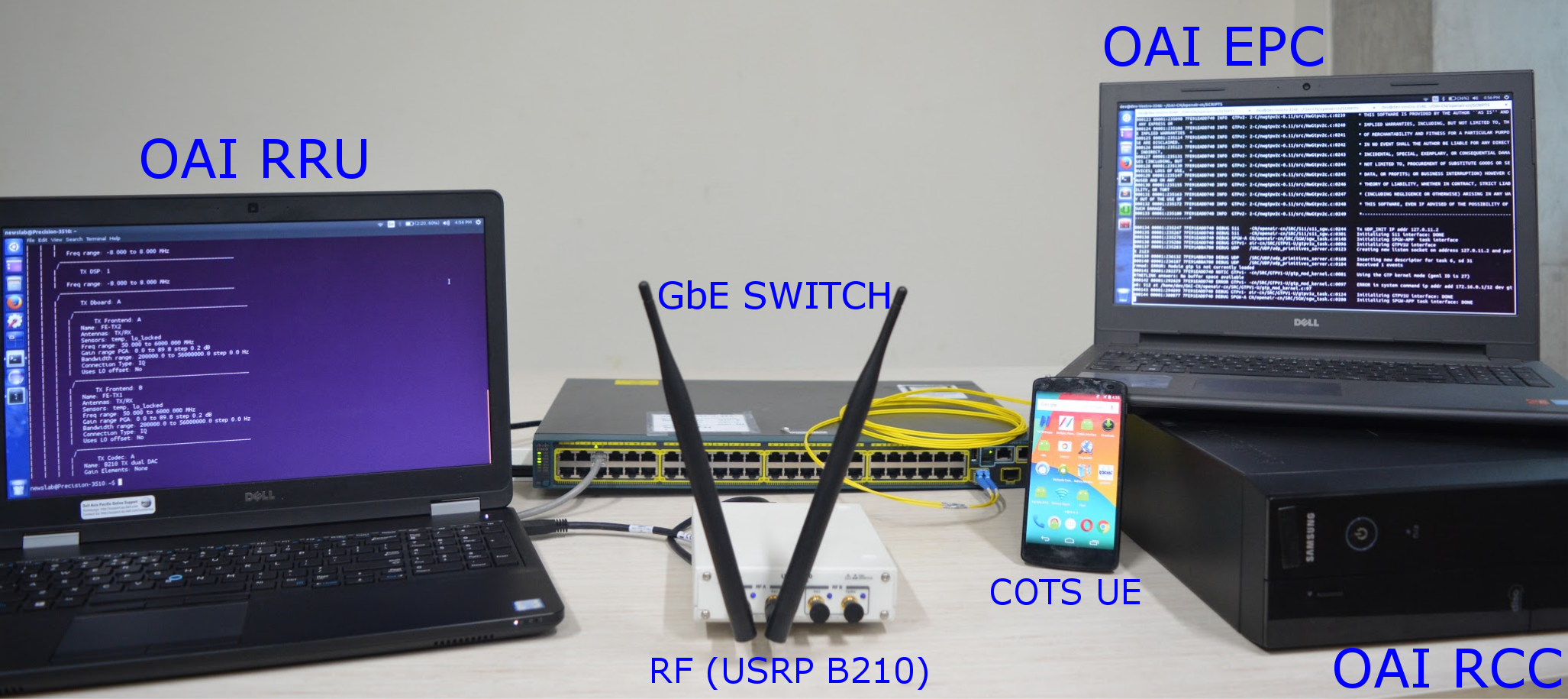C RAN
Cloud RAN (C-RAN) is a novel radio access network (RAN) architecture for cellular networks which has potential to greatly help mobile operators to improve their capacity with reduced CAPEX and OPEX. The concept of C-RAN is based upon the idea of centralization of baseband processing resources (BBU pool) on a cloud leaving out the antennae and some part of RF components at cell site called Remote Radio Heads (RRHs). This functional split of traditional base station (e.g., LTE eNodeB) helps to save CAPEX and OPEX by providing energy efficient solutions to save power consumed, boost network capacity by balancing processing load across multiple BBUs, and cooperative signal processing at the central cloud system. The distributed RRHs are connected to the centralized cloud based BBU pool with the help of high speed links for carrying Inphase and Quadrature (IQ) data samples.
Some of the key research topics on C-RAN that our research group is focussing are quantifying multiplexing gain, efficient IQ data sample compression, coordination techniques in centralized BBUs, BBU virtualization and RRH provisioning with live migration.
Quantifying BBU Multiplexing Gains in C-RAN Architecture: Traditional cellular base station architectures possess an 1:1 static assignment between RRHs and BBUs. This static 1:1 mapping is not desired for large scale cellular network deployment as diurnal traffic dynamism tends to over utilize or under utilize BBU resources of the cloud. Hence, the basic goal is to optimally use BBUs by dynamically balancing workloads which are generated at cell sites according to spatio-temporal variations of mobile subscriber’s traffic demands. This would facilitate energy savings opportunities and resource pooling gains in cloud RAN . So there is a need for design of time efficient real time algorithms for inclusion decision of RRHs in many-to-one mapping to BBUs as well as the overhead estimation in centralized cloud for this multiplexing.
Real-time experiments using test-bed or field trials in C-RAN: At NeWs lab, we are focussing on using OpenAirInterface (OAI) platform for setting up our own C-RAN test-bed. The OAI test-bed at NeWS lab is equipped with many ExpressMIMO2 boards that can be programmed at RRH and the BBU pool can be run on our high end servers. The proposed RRH algorithms should be implemented and tested on this OAI test-bed to find the real multiplexing gains and algorithm complexities. Our OAI test-bed platform is described in detail as given below.
C-RAN testbed using OAI @ NeWS lab: The challenges and difficulties in C-RAN can be well addressed by conducting extensive field trials, simulations and emulations of C-RAN system. Our C-RAN testbed is based on 3GPP standard and it can be updated with continuous evolving 3GPP standards. OpenAirInterface (OAI) with LTE implementation provides real-time implementation opportunities for future cellular networks like 5G. In general OAI provides an environment for experimentation with simulation/emulation/field trial with the same implementation code.This SDR based x86 architecture can be efficiently run on a commodity hardware covering the 3GPP defined full LTE protocol stack. We can exploit this fully x86-based SDR solution in open-source, providing all LTE components such as UE, eNB, and core-network functionalities. OAI is written in standard C with real time environment support (RTAI in linux) and is distributed as free software under GPLv3.

[J1] Himank Gupta, Mehul Sharma, Antony Franklin A, and Bheemarjuna Reddy Tamma, “Apt-RAN: A Flexible Split Based 5G RAN to Minimize Energy Consumption and Handovers” IEEE Transactions on Network and Service Management, 2019.
[J2] F. Giannone, K. Kondepu, Himank Gupta, A. Franklin A, P. Castoldi, and L. Valcarenghi, “Impact of Virtualisation Technologies on Virtualised RAN Midhaul Latency Budget: A Quantitative Experimental Evaluation” IEEE Communications Letters, February 2019. [ Accepted Version ] [ DOI Link ]
[C1] Debashisha Mishra, Himank Gupta, Mehul Sharma, B. Reddy Tamma, and A. Franklin A, “A Matching-theoretic Framework for Consolidation of Flexible Cloud-native Central Units in 5G-RAN” in Proceedings of the 2019 IEEE International Conference on Advanced Networks and Telecommunications Systems (ANTS), India.
[C2] Debashisha Mishra, Himank Gupta, B. Reddy Tamma, and A. Franklin A, “Kora: A framework for dynamic consolidation relocation of control units in virtualized 5G RAN” in Proceedings of sthe 2018 IEEE International Conference on Communication (ICC), Kanas City, USA. [ Accepted Version ] [ DOI Link ] [Presentation]
[C3] Himank Gupta, D. Manicone, F. Giannone, K. Kondepu, A. Franklin, P. Castoldi, and L. Valcarenghi, “How much is fronthaul latency budget impacted by ran virtualisation ?” in Proceedings of the 1 st International Workshop on Federated Testbeds for NFV/SDN/5G: Experiences and Feedbacks (Co-located with IEEE NFV-SDN 2017), Berlin, Germany. [ Accepted Version ] [ DOI Link ] [Presentation]
[C4] F. Giannone, Himank Gupta, D. Manicone, K. Kondepu, A. Franklin, P. Castoldi, and L. Valcarenghi, “Impact of ran virtualization on fronthaul latency budget: An experimental evaluation” in Proceedings of the International Workshop on 5G Test-Beds and Trials Learning from Implementing 5G (Co-located with IEEE GLOBECOM 2017), Singapore. [ Accepted Version ] [ DOI Link ] [Presentation]
[C5] Debashisha Mishra, Amogh PC, Arun Ramamurthy, Antony Franklin, and Bheemarjuna Reddy Tamma, "Load-Aware Dynamic RRH Assignment in Cloud Radio Access Networks" in Proc. of IEEE WCNC, April 2016, Doha, Qatar. [ Accepted Version ] [ DOI Link ] [Presentation]
[D1] S. Sandeep Kumar, Raymond Knopp, Navid Nikaein, Debashisha Mishra, Bheemarjuna Reddy Tamma, Antony Franklin A, Kiran Kuchi, and Rohit Gupta, "FLEXCRAN: Cloud Radio Access Network Prototype using OpenAirInterface", in Proc. of COMmunication Systems and NETworkS (COMSNETS 2017), January 2017. [ Accepted Version ] [ DOI Link ]
R&D Equipment:



